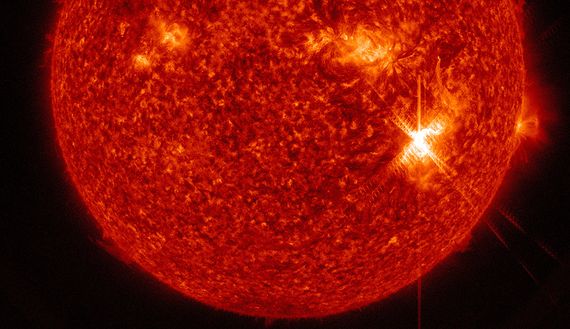At the beginning of September 1859, the skies were filled with an intense and radiant light that seemed to contain all the colours of nature. In itself this was not so strange, as it was the beautiful celestial phenomenon of the aurora. The peculiarity was that the illuminated skies reached latitudes that usually resist its glow: Colombia, Cuba, Hawaii, Japan, China. It is said that the light was so intense that the miners of the Rocky Mountains sipped their breakfast coffee thinking that the day had already risen, while the telegraph systems of Europe and North America were silenced.
Two amateur English astronomers, Richard Carrington and Richard Hodgson, attributed the event to a massive solar storm, and thereafter it became known as the Carrington event. Today it is still the most intense geomagnetic storm ever recorded.

The Carrington event has been on the minds of scientists ever since, generating various questions. One is about the consequences that a solar storm of this type would have on the tangle of electrical wires that encircle our planet today and that govern our lives from sunrise to sunrise. A study by the insurance company Lloyds calculated that the cost of a new Carrington event in the United States could reach 2.5 trillion dollars with its power grid affected for up to two years.
Another question, just as disturbing, is about the timing: when is the next Carrington event going to occur?
Searching for new mathematical models
In 2012, a study by solar scientist Pete Riley estimated that the probability of a Carrington-like (or worse) solar storm over the next 10 years was around 12%. A new mathematical model, Recently published in Scientific Reports, reduces this probability to about 2%.
Its authors, David Moriña, Isabel Serra, Pere Puig, and Álvaro Corral, researchers at the Universidad Autónoma de Barcelona, the Centro de Investigación Matemática and the Barcelona Graduate School of Mathematics, use mathematics to understand the apparently erratic behaviour of natural disasters—earthquakes, hurricanes, solar storms—, everything that sometimes happens intensely, suddenly, and is therefore difficult to predict. They try to look for some logic, for an invisible pattern that directs their behaviour and that in the eyes of the lay-person would not go beyond the whims of chance.
“Our job is to try to understand extremes in order to incorporate them into predictive models. Extremes are often points where deterministic models, mathematical or physical, have failed in some way, but so have the usual statistical models, because they are not used to working at extremes, but on average. Most things don’t happen higgledy-piggledy. There’s almost always some information you can get your teeth into,” explains mathematician Isabel Serra. In the case of solar storms, the insight that governed this research is that a few days after the Carrington event there was another event of some size. This was the clue.
Riley’s model was based on the hypothesis that these events occur independently, so that the waiting time between them is more or less similar, i.e. they always occur with the same probability. In mathematical jargon this is called a Poisson Process and many physical processes follow this behaviour. However, when they statistically analysed the frequency with which these intense solar storms occurred—which they measure with the so-called DST index supplied by the WDC Kyoto Observatory—they saw that they occurred with a slightly more complex pattern.
Decreasing hazard rate
“What we observe is that the more time that goes by without observing an extreme event, the longer we have to wait to see one again; if one day an event occurs, the probability increases and the next day it is more likely that there will be another. This is called the decreasing hazard rate (DHR). This also governs many natural phenomena, such as infant mortality: when a child is born it may die, but every day that passes without this happening it is more likely that it will no longer do so: its probability of continuing to survive increases. When the person reaches adulthood the reverse happens: every day that passes they are more likely to die and it becomes an increasing hazard rate (IHR). In the case of solar storms, a DHR was observed,” explains the mathematician.

With this perspective in mind, they calculated a maximum probability close to 2%, although, in the absence of a Carrington event next year, for example, it would continue to fall. “It’s really not a very different model, but rather a more general model that includes Riley’s model. For example, there might be some factor that helped that severe storm to occur and it is reasonable to think that over time that factor is disappearing and, therefore, it is less and less likely that such an event will occur again. That could be a very speculative explanation,” Serra explains.
Although a probability close to 2% does not seem too worrying, for a very intense superstorm, the risk “is not negligible considering its consequences,” notes mathematician Pere Puig. “Governments should have protocols for action in the face of these disasters, informing and reassuring the population that may be left without electricity and incommunicado. Let’s remember that there will be a very little margin of time before the unexpected arrival of a storm of this kind,” Puig concludes.
Comments on this publication